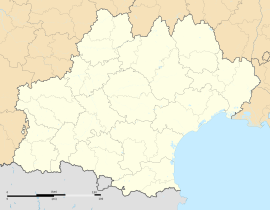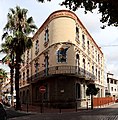Le Boulou
Le Boulou
El Voló | |
|---|---|
 A general view of Le Boulou | |
| Coordinates: 42°31′29″N 2°49′51″E / 42.5247°N 2.8308°E | |
| Country | France |
| Region | Occitania |
| Department | Pyrénées-Orientales |
| Arrondissement | Céret |
| Canton | Vallespir-Albères |
| Intercommunality | Vallespir |
| Government | |
| • Mayor (2020–2026) | François Comes[1] |
Area 1 | 14.42 km2 (5.57 sq mi) |
| Population (2022)[2] | 5,396 |
| • Density | 370/km2 (970/sq mi) |
| Time zone | UTC+01:00 (CET) |
| • Summer (DST) | UTC+02:00 (CEST) |
| INSEE/Postal code | 66024 /66160 |
| Elevation | 55–363 m (180–1,191 ft) |
| 1 French Land Register data, which excludes lakes, ponds, glaciers > 1 km2 (0.386 sq mi or 247 acres) and river estuaries. | |
Le Boulou (French pronunciation: [lə bulu] ⓘ; Catalan: El Voló [əl βuˈlo]) is a commune in the Pyrénées-Orientales department in southern France.
It is situated 12 km from the Spanish border.
Geography
[edit]Localisation
[edit]The town of Le Boulou is located in the canton of Vallespir-Albères and in the arrondissement of Céret, in the south of Pyrénées-Orientales.

Toponymy
[edit]The name of the town in catalan is El Voló.[3]
History
[edit]In the 10th century, the territory of Le Boulou appears to be shared between the lord of Saint-Jean-Pla-de-Corts, lady Minimilla, and the church of Elne. Le Boulou is then ruled by the lords of Montesquieu from the 11th to the 14th centuries. It finally becomes part of the crown lands.[4]
At the end of the 17th century, Bernard de Kennedy, following the court of James II of England in France, decides to settle in Le Boulou and receives French citizenship from Louis XIV of France. His grandson, Côme de Kennedy, is granted a title of lord of Le Boulou in 1755. Côme's son, Joseph de Kennedy is the running lord during the French Revolution. But his house is used as a headquarter by the Spanish general Antonio Ricardos during the first battle of Boulou in 1793. Accused of betrayal, Joseph de Kennedy is sent to the guillotine on 2 May 1794, on the next day after the second battle of Boulou.[5]
In the 20th century Le Boulou was the site of a camp housing female Republican escapees from Spain at the end of the Spanish Civil War.[6] It was opened as a clearing centre, but there was no shelter and most of the women and children were removed to other parts of France, along with some wounded soldiers.[7] During the German occupation the spa at Le Boulou was a Gestapo headquarters.[8]
-
Old town Hall (1912)
-
Church Sainte-Marie
Government and politics
[edit]Mayors
[edit]| Mayor | Term start | Term end |
|---|---|---|
| Marie-Rose Careras | 1987 | 1995 |
| Jean-Pierre Salgas | 1995 | 2008 |
| Christian Olive | 2008 | 2014 |
| Nicole Villard-Schlatter | 2014 | 2020 |
| François Comes | 2020 |
Population
[edit]| Year | Pop. | ±% p.a. |
|---|---|---|
| 1968 | 2,921 | — |
| 1975 | 3,709 | +3.47% |
| 1982 | 4,292 | +2.11% |
| 1990 | 4,436 | +0.41% |
| 1999 | 4,428 | −0.02% |
| 2007 | 5,175 | +1.97% |
| 2012 | 5,520 | +1.30% |
| 2017 | 5,514 | −0.02% |
| Source: INSEE[9] | ||
Culture
[edit]This section is empty. You can help by adding to it. (January 2014) |
See also
[edit]References
[edit]- ^ "Répertoire national des élus: les maires" (in French). data.gouv.fr, Plateforme ouverte des données publiques françaises. 13 September 2022.
- ^ "Populations de référence 2022" (in French). The National Institute of Statistics and Economic Studies. 19 December 2024.
- ^ Nomenclàtor toponímic de la Catalunya del Nord
- ^ (in French) Jean Sagnes (dir.), Le pays catalan, t. 2, Pau, Société nouvelle d'éditions régionales, 1985
- ^ Cárdenas, Fabricio (2014). 66 petites histoires du Pays Catalan [66 Little Stories of Catalan Country] (in French). Perpignan: Ultima Necat. ISBN 978-2-36771-006-8. OCLC 893847466.
- ^ Beevor, Antony (2001). The Spanish Civil War. London: Cassell Military Paperbacks. p. 394. ISBN 0-304-35840-1.
- ^ Thomas, Hugh (2012). The Spanish Civil War (50th Anniversary ed.). London: Penguin Books. p. 855. ISBN 978-0-141-01161-5.
- ^ "With Death Snapping at Their Heels: Tales from Europe's "wild West"".
- ^ Population en historique depuis 1968, INSEE






